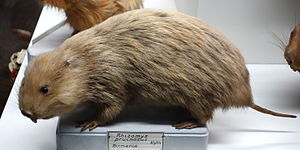Gray bamboo rat
| Gray bamboo rat | ||||||||||||
|---|---|---|---|---|---|---|---|---|---|---|---|---|

Gray bamboo rat ( Rhizomys sumatrensis , stuffed specimen) |
||||||||||||
| Systematics | ||||||||||||
|
||||||||||||
| Scientific name | ||||||||||||
| Rhizomys pruinosus | ||||||||||||
| Blyth , 1851 |
The gray bamboo rat ( Rhizomys pruinosus ), also gray Indian root rat , is a rodent species from the genus of bamboo rats ( Rhizomys ). It occurs in East Asia and Southeast Asia from the People's Republic of China to northeast India , Myanmar , Thailand , Laos , Cambodia , Vietnam and the Malay Peninsula .
features
The gray bamboo rat reaches a head-trunk length of 24.0 to 34.5 centimeters with a tail of 9.0 to 13.0 centimeters in length and a weight of about 1500 to 2500 grams. The rear foot length is 40 to 50 millimeters, the ear length 13 to 20 millimeters. The back fur is gray-brown to chocolate brown, darker on the back than on the belly. On the back there are sensory hairs, which have a white tip, from which a grayish appearance emerges.
| 1 | · | 0 | · | 0 | · | 3 | = 16 |
The skull reaches a length of 56 to 71 millimeters. It is wide and flattened, the muzzle is comparatively wide. The zygomatic arch is large and wide and the occiput is clearly defined. There is a distinct forehead crest on the skull. The animals have like other Spalacidae maxillary per half an an incisor tooth trained incisors (incisive) to which a tooth gap ( diastema follows). This is followed by three molars , premolars missing. In total, they have a set of 16 teeth.
distribution
The gray bamboo rat is found in East Asia and Southeast Asia from the People's Republic of China south of the Yangtze River in the provinces of Yunnan , Guizhou , Sichuan , Jiangxi , Hunan , Guangxi , Guangdong and Fujian to the north and northeast of India in Meghalaya , Nagaland and Manipur , Myanmar , Thailand , Laos , Cambodia , Vietnam and the Malay Peninsula . The height distribution ranges from 400 to a maximum of 4000 meters.
Way of life
The gray bamboo rat lives mainly in the lowlands in bamboo forests or grassy areas. In areas where it is sympatric with the Chinese bamboo rat ( Rhizomys sinensis ), the gray bamboo rat usually occurs at altitudes below 1000 meters while the Chinese bamboo rat lives in the higher areas.
The animals live as solitary animals in comparatively simple structures with a single entrance that can be recognized by an ejection mound. There are also the tunnels, the nest with a diameter of 12 to 32 centimeters, a toilet area and an escape exit. The nests are laid out with grass and bamboo leaves. The animals come to the surface at night and feed on the shoots and trunks of the bamboo plants and the grasses of their habitats, plus roots and other plants and parts of plants.
Reproduction takes place throughout the year, with a particularly large number of offspring in November and December and March to June. During the mating season, the males come into the females' burrows. The gestation period lasts 22 days, the litters usually consist of five young animals that are born as nestlings . Weaning from breast milk takes place 56 to 78 days after birth.
Systematics

The gray bamboo rat is classified as an independent species within the genus of bamboo rats ( Rhizomys ), which consists of three species. The first scientific description comes from Edward Blyth from 1851, who described the species on the basis of individuals from Cherrapunji in the Khasi Hills in India .
Status, threat and protection
The International Union for Conservation of Nature and Natural Resources (IUCN) classifies the gray bamboo rat as Least Concern. This is justified with the very large distribution area and the assumed large populations of the species.
Since the animals are easy to find and catch, they are hunted as a source of meat in some parts of the range. In Southeast Asia, habitat loss and habitat degradation is a major factor in the endangerment of the species.
supporting documents
- ↑ a b c d e f Andrew T. Smith: Hoary Bamboo Rat. In: Andrew T. Smith , Yan Xie: A Guide to the Mammals of China. Princeton University Press, Princeton NJ 2008, ISBN 978-0-691-09984-2 , p. 213.
- ↑ Andrew T. Smith: Family Spalacidae. In: Andrew T. Smith , Yan Xie: A Guide to the Mammals of China. Princeton University Press, Princeton NJ 2008, ISBN 978-0-691-09984-2 , p. 209.
- ↑ a b c d Rhizomys pruinosus in the IUCN Red List of Threatened Species 2015.4. Posted by: K. Aplin, D. Lunde, S. Molur, 2008. Retrieved July 20, 2016.
- ^ John Anderson : Anatomical and Zoological Researches: comprising an account of the Zoological results of the two expeditions to Western Yunnan in 1868 and 1875. Bernard Quaritch, London 1878.
- ↑ Rhizomys pruinosus . In: Don E. Wilson , DeeAnn M. Reeder (Eds.): Mammal Species of the World. A taxonomic and geographic Reference. 2 volumes. 3. Edition. Johns Hopkins University Press, Baltimore MD 2005, ISBN 0-8018-8221-4 .
literature
- Andrew T. Smith: Hoary Bamboo Council. In: Andrew T. Smith , Yan Xie: A Guide to the Mammals of China. Princeton University Press, Princeton NJ 2008, ISBN 978-0-691-09984-2 , p. 213.
Web links
- Rhizomys pruinosus inthe IUCN Red List of Threatened Species 2015.4. Posted by: K. Aplin, D. Lunde, S. Molur, 2008. Retrieved July 20, 2016.